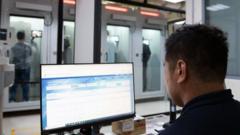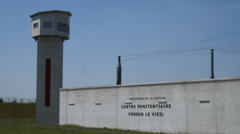With some of the harshest drug laws globally, Singapore's stance on cannabis use leads to severe consequences for those caught, including lengthy jail sentences and mandatory rehabilitation. This article explores the journeys of Kim and other individuals entangled in the legal system, as well as the criticisms surrounding the country’s approach to drug addiction.
Singapore's Drug Policy: Harsh Realities of Cannabis Trafficking and Compulsory Rehabilitation

Singapore's Drug Policy: Harsh Realities of Cannabis Trafficking and Compulsory Rehabilitation
A look into Singapore's stringent drug laws and the experiences of individuals caught in the web of cannabis trafficking and enforced rehabilitation.
The penalties for drug offenses in Singapore remain severe, particularly concerning cannabis usage. Kim, a young professional who used cannabis to cope with personal issues, found herself entangled in a criminal web when a friend she supplied was arrested. In Singapore, the possession of drugs can result in immediate implications—if caught with 15g of cannabis, you are presumed a trafficker, facing a minimum sentence of five years in prison.
While her friends were dealt with leniently as consumers and sent to a state-run Drug Rehabilitation Centre (DRC) for six months, Kim faced criminal charges that could result in a lengthy prison term. The legal framework in Singapore operates with a zero-tolerance policy towards drugs, leaving no room for leniency. In extreme cases, those found with substantial amounts of narcotics face the death penalty—a chillingly swift consequence for drug trafficking.
The DRC, a facility signifying incarceration disguised as rehabilitation, prevents any sense of comfort for detainees. Consisting of cells shared by multiple inmates, the conditions reflect a rigorous approach aimed not only at treatment but deterrence. Inmates partake in courses designed to foster a mindset against drug use, but many still face challenges with reintegration into society once their time is served.
Reflection on the outcomes of the DRC’s programs brings varying opinions. While some experts note improvements in treatment due to the presence of trained psychologists, critics maintain that the harsh environment continues to harm rather than heal. The Transformative Justice Collective, among others, highlights the emotional toll inflicted by such punitive measures, as it is believed that the systems in place often exacerbate instead of alleviate the issues surrounding drug dependency.
Despite the critiques, the government insists that drug users who have exhibited no threat to society should not be treated as criminals. New approaches attempt to ensure those completing mandatory rehabilitation have access to reintegration resources. However, stringent monitoring post-release remains, with systems such as electronic tracking and drug testing continuing to scrutinize those recovering from addiction.
As Kim awaits her trial, she grapples with the reality of potential incarceration—joining a concerning statistic in Singapore, which boasts over 2,200 individuals serving time for drug-related offenses in the previous year. This narrative continues to unfold in a nation where a culture of fear and stigma around drug use remains pervasive. The consequences of Singapore's drug policies underline a broader conversation on the balance between effective interventions and humane treatment of individuals grappling with addiction.
While her friends were dealt with leniently as consumers and sent to a state-run Drug Rehabilitation Centre (DRC) for six months, Kim faced criminal charges that could result in a lengthy prison term. The legal framework in Singapore operates with a zero-tolerance policy towards drugs, leaving no room for leniency. In extreme cases, those found with substantial amounts of narcotics face the death penalty—a chillingly swift consequence for drug trafficking.
The DRC, a facility signifying incarceration disguised as rehabilitation, prevents any sense of comfort for detainees. Consisting of cells shared by multiple inmates, the conditions reflect a rigorous approach aimed not only at treatment but deterrence. Inmates partake in courses designed to foster a mindset against drug use, but many still face challenges with reintegration into society once their time is served.
Reflection on the outcomes of the DRC’s programs brings varying opinions. While some experts note improvements in treatment due to the presence of trained psychologists, critics maintain that the harsh environment continues to harm rather than heal. The Transformative Justice Collective, among others, highlights the emotional toll inflicted by such punitive measures, as it is believed that the systems in place often exacerbate instead of alleviate the issues surrounding drug dependency.
Despite the critiques, the government insists that drug users who have exhibited no threat to society should not be treated as criminals. New approaches attempt to ensure those completing mandatory rehabilitation have access to reintegration resources. However, stringent monitoring post-release remains, with systems such as electronic tracking and drug testing continuing to scrutinize those recovering from addiction.
As Kim awaits her trial, she grapples with the reality of potential incarceration—joining a concerning statistic in Singapore, which boasts over 2,200 individuals serving time for drug-related offenses in the previous year. This narrative continues to unfold in a nation where a culture of fear and stigma around drug use remains pervasive. The consequences of Singapore's drug policies underline a broader conversation on the balance between effective interventions and humane treatment of individuals grappling with addiction.




















